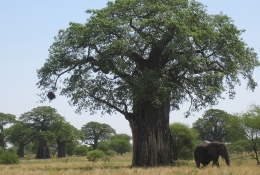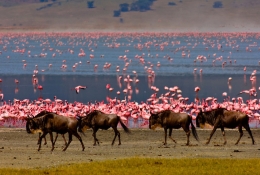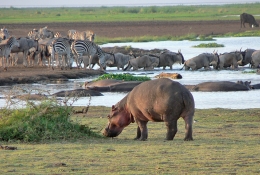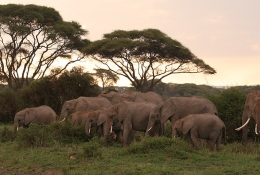
Tsavo National Park
This is the largest national park in Kenya at around 21’000 km2. It lies in the southern part of the country, halfway between Mombasa — Nairobi railway and road link. For administrative purposes it has been split into two sections, Tsavo East (11’747km2), lying to the east of the Nairobi — Mombasa road/railway is the part of the park made famous by the ‘Man Eaters of Tsavo’, and Tsavo West (9’065 km2).
1. Tsavo East National Park
Attractions:
It mainly consists of vast plains of scrubland home to huge herds of elephants. The landscape is vast, and empty of any sign of humans, dotted with baobab trees. The wildlife includes all of the ‘big five’ (the lion, leopard, buffalo, elephant and rhinoceros), plus zebras, giraffes, impalas, gazelles, elands and cheetahs, and there are over 500 species. The Kanderi Swamp, not far from the main entrance at Voi Gate, has the most wildlife in the area.
The main attraction in this part of the park is the Aruba dam built across the Voi River where many animals and bird congregate. Mudanda Rock, about 30 km north of Voi, is a 1.6-km long outcrop of rock that towers above a natural dam and at certain times during the dry season draws hundreds of elephants. The Yatta Plateau, at about 290 km long the world’s largest lava flow, is also found in Tsavo East.
The Lugard Falls on the Galana River, 40 km northeast of Voi are pretty spectacular. They are series of rapids rather than true falls. The rocks have been sculpted into fascinating shapes by the rapid water flow that is channeled into a gorge so narrow that it is possible to stand with legs spanning the cleft, overlooking the falls.
How to get there:
The same road is used as the one for Tsavo West National Park (Nairobi — Mombasa road) and then enter at the park Headquarters at Voi Gate. There is a small educational centre at Voi Gate. If you are coming from Malindi, it is 110 km up to Sala Gate on the eastern side of the park. There’s a road cutting across to the Galana River and on up to Manyani Gate on the Mombasa — Nairobi road.
2. Tsavo West National Park:
Attractions:
This is the more developed part of the park combining easy access, good facilities and stunning views over the tall grass and woodland scenery. The area is made up from recent volcano lava flows, which absorb rainwater that reappears as the crystal clear Mzima Springs, 40 km away. The environment is well watered and this, combined with volcanic soils, supports a vast quantity and diversity of plant and animal life.
The main attractions are the watering holes by kilaguni and Ngulia lodges that entice a huge array of wildlife particularly in the dry season.
During the autumn, the areas around Ngulia Lodge are a stopover for hundreds of thousands of birds from Europe in their annual migration south. Not far from Kilaguni Lodge, is the Mzima Springs, a favourite haunt of hippopotamuses and crocodiles. There’s an underwater viewing chamber here, but the hippos have obviously decided against being studied too closely by moving to the other side of the pool. Also around the lodges are the spectacular Shaitani lava flow and cones, as well as caves that are well worth visiting. You’ll need to bring a good torch to explore them. Chaimu crater to the south of Kilaguni Lodge can be climbed and though there’s little danger of animals here, it is best to be careful.
Chyulu Hills National Park was established recently as an extension to Tsavo West National Park. Here, the long mountain range is home to lions, giraffes, zebras ad oryx. Described as being the youngest mountain range in the world, it is made up of intermingled volcanic cones and lava flow. Kilimanjaro is clearly visible from the crest of the Chyulu Hills. At the extreme southwest of the park, bordering Tanzania is the beautiful Lake Jipe, which is fed by underground aquatic flows from the Mount Kilimanjaro. Here, there are the pygmy geese and the black heron with many other bird species.
The wildlife you are likely to spot include the hyraxes, agama lizards, dwarf mongooses, marabou storks, baboons, antelopes, buffalos, zebras, giraffes, jackals and hyenas, crocodiles, hippos, leopards, lions, cheetahs and so on. This part of Tsavo has some black rhinoceros as well.
How to get there:
The park headquarters are off the Mombasa — Nairobi road at the northern end of the park through Mtito Andei Gate. The gate is about 220 km from Nairobi and 255 km form Mombasa. It is 30 km from here to Kilaguni Lodge in the park. This is the busiest entrance to the park, and therefore the best one to aim for if you intend to hitch your way through the park. If you drive along the same Mombasa — Nairobi road for 48 km, you come to Tsavo Gate. The journey usually takes about 31/2 hours.










